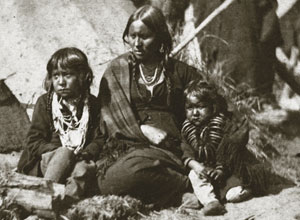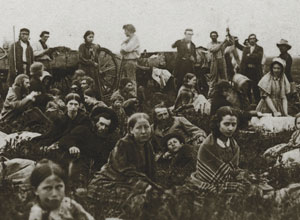Throughout 2012, the Minnesota Historical Society will introduce a wide range of initiatives to encourage discussion and reflection about the war. This website shares historical background, a timeline of events, public programs, books, links to photos, documents and artifacts relating to the war, and also resources for researching family history.

Little Crow's wife and children at Fort Snelling - ca. 1863

Missionaries escaping from the fighting. - Aug. 21, 1862
BRIEF HISTORICAL BACKGROUND
The U.S.-Dakota War of 1862 followed years of broken treaties and promises to the Dakota people combined with a burgeoning white population in the state. In August 1862, when late annuity payments and the refusal by agents and traders to release provisions found some Dakota facing starvation, factions attacked white settlements, the Lower Sioux Agency and Fort Ridgely in south central and southwestern Minnesota. A significant number of Dakota were against the war and did not participate.
The fighting lasted six weeks. Between four and six hundred white civilians and soldiers were killed. The number of Dakota killed in battle is not known. Troops under the command of former Gov. Henry Sibley were sent to support Fort Ridgely and the settlers, ultimately defeating the Dakota forces and bringing the war to a close by the end of September 1862.
After a trial by military tribunal, 38 Dakota men were hanged in Mankato on Dec. 26, 1862. It remains the largest mass execution in U.S. history. More than 300 Dakota men had initially been condemned to death but President Abraham Lincoln commuted all but 39 of the sentences. Another was reprieved at the last minute because of questions about the testimony used to convict him.
Approximately 1600 Dakota and mixed-race people at Camp Release near Montevideo (so named because friendly Dakota had gathered 269 captives there to release to Sibley after the Dakota were defeated at the Battle of Wood Lake) were taken into U.S. Army custody. In November the prisoners, mostly women, children, the elderly, non-combatants and others who had filtered into the camp, were taken in a six-day march to Ft. Snelling. There, they were held over the winter of 1862-63 in an internment camp, sometimes called a concentration camp, below the fort. As many as 300 Dakota prisoners died over the winter, victims of illness and attacks by civilians and soldiers. Eventually, they were forcibly removed from the state to reservations in the Dakota Territory and what is now Nebraska. The convicted prisoners whose death sentences were commuted were transported to a military prison at Camp McClellan, near Davenport, Iowa.
Thousands of Dakota had fled the state to Dakota Territory following the Battle of Wood Lake. Punitive expeditions into the territory in 1863 and 1864, led by Sibley and Gen. Alfred Sully, a Civil War veteran, resulted in three battles in which hundreds of Dakota were killed or forced farther westward. Although these expeditions effectively ended the war between the Dakota and the U.S. government that started in Minnesota, conflict continued in bloody battles at Fort Phil Kearney, the Little Big Horn, and finally, in 1890, at Wounded Knee.
While the U.S.-Dakota War of 1862 lasted just six weeks, the issues surrounding its causes went on for decades and its aftermath continues to affect Minnesota and the nation to this day.




